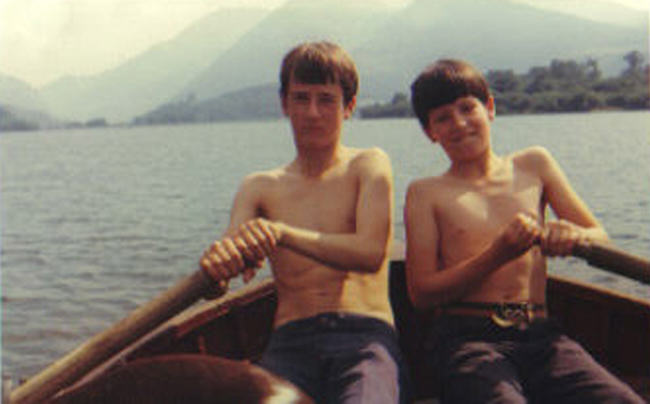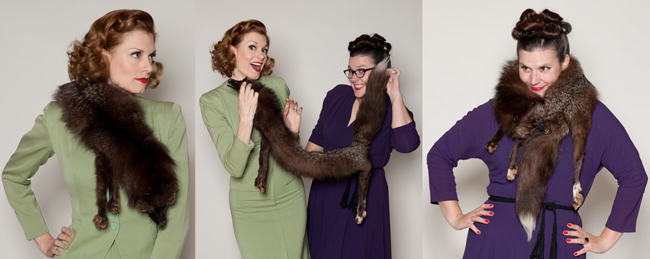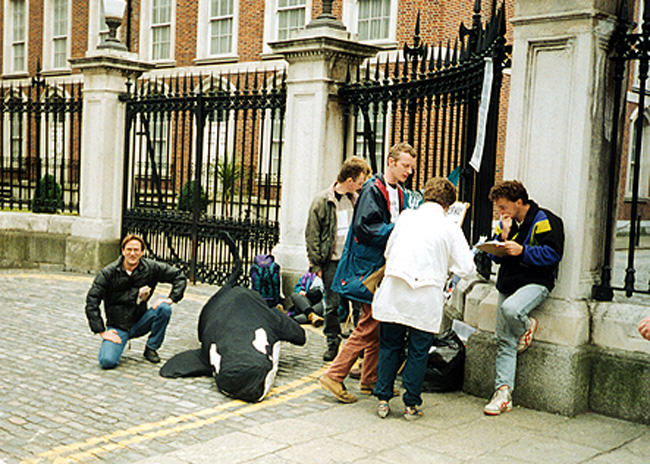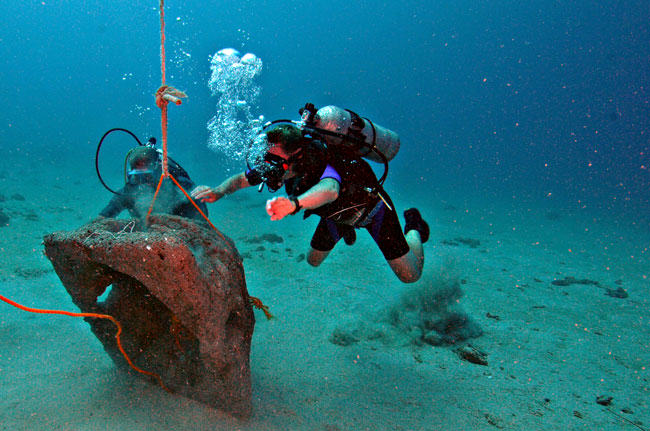
Don’t give up on animal activists. People change. I know because I was an animal activist, and I’ve spent the last 24 years doing PR for animal users, including the last 18 for the fur trade. I’m telling my story in the hope you will reach out to that unkempt youth with a placard outside your fur store or farm. Because that person was once me, and someone reached out and opened my eyes.
***
A wise person, some say Winston Churchill, once said, “If you’re not a liberal when you’re 25, you have no heart. If you’re not a conservative by the time you’re 35, you have no brain.”
Yes, it’s a sweeping statement, but there’s a kernel of truth in it for many of us.
There’s also a kernel of truth in my less-pithy variant. If you’re 25 and have never even considered the possibility that it may be wrong to kill animals for food and clothing, you have no heart. If you’re 35 and still can’t decide, no, it doesn’t mean you have no brain. You just need to wait for the right formative moments.
This is a journey I’ve taken in life, and I’m sure it’s a common one, especially for people who were not born into hunting or ranching. I come from England, not Saskatchewan or Montana. My father was an insurance claims assessor and my mother a nurse, and terms like “gun range” or “conibear” weren’t in our vocabulary. I never viewed the taking of animal life as an everyday event, but a leg of lamb on Sunday was one of my happiest childhood memories. With freshly made mint sauce!
But I wasn’t totally sheltered either. We had an acre of land and some livestock, so I soon learned how to kill a chicken. And Dad was a keen fly fisherman, so I could kill a trout too.
He also taught me to respect animal life and the meaning of conservation. He helped me build my birds’ egg collection, but with rules. For example, never take an egg if it was the only one in the nest, or if I already had it in my collection. And anything I killed I ate, which was an easy rule to follow because I only ever killed chickens and trout.
Hunt Sab Girls
During my teens, nothing happened to shape my view on the taking of animal life, and why would it? My head was full of motorbikes, girls, beer and cigarettes.
Then came my first formative moment, at age 21, though I had no idea it was happening, perhaps because it still revolved around girls.
A friend, Tim, had become a fox hunt saboteur and was having a great time, but it wasn’t because he was saving foxes. It turned out hunt sabbing was a great way to meet crazy girls! Since I already knew more than enough crazy girls, I wasn’t interested in joining, but he started preaching and it sunk in. The secret to picking up hunt sab girls, he explained, was to be passionate in your hatred of three things: fur, veal and whaling.
I doubt he really hated these things, but he planted a seed in my brain that fur and veal were cruel, and all whales were being hunted to extinction. Since I didn’t know anyone who wore fur, ate veal, or had even seen a whale, I never questioned Tim, and no one else ever tried to set me straight.
In hindsight, the only truth I gleaned from Tim was that girls like “sensitive” guys, and “sensitive” guys “love” animals. This I still believe to be true!
That Fox Stole
At age 26, I was living in Italy and picking up my lady to go to a party. As always, she was casual but glamorous, with her big Stefanie Powers hair, but there was this thing draped around her neck. It was grandma’s fox stole, she said, but it was so much more. To be precise, it was a head, four paws, and a tail more!

I remember feeling instant revulsion, but why? Was it just Tim’s anti-fur indoctrination surfacing, or was it a visceral reaction to that head, paws and tail? Probably a bit of both. Whatever the case, I asked her to remove it, which she did, without question. And that was the first and last time I made a stand against fur.
My stand against veal was even less distinguished. I’d seen it on menus a few times, and all I had to do to lodge my protest was not to order it. Then one day a friend’s date ordered it, and I mumbled something about being opposed. So she asked if I’d ever tried it, and offered me a taste. I ate it, liked it, and that was the end of anti-veal activist me.
All in all, I was a pathetic animal activist, no doubt about it. I needed a cause I believed in! Maybe I was instead destined to be a conservationist, and my only cause left standing was whales. Since there were only a handful left and Japan wanted to kill them all, surely even I could follow through!
Whaling Time
And then, as fate would have it, at age 29 I landed a job in Tokyo with a trade paper owned by one of Japan’s largest newspapers, the Asahi Shimbun. The country’s whaling fleet was embarking on its last season of commercial operations in the Antarctic, and the Asahi Shimbun was honouring them with a photo exhibit in its atrium.
At last I could do the right thing! I made up some signs saying “STOP WHALING NOW”, and late one evening plastered them all over the photo exhibit.
The next morning, of course, they were all gone, but a Canadian lady in my office had seen them and suspected me as the culprit. I confessed, and why wouldn’t I? I was proud!
Well, that bubble was soon burst. What kind of whales are they catching? she asked. No idea. Do you know the whales they’re catching are abundant? I did not know that. What do you think they use them for, oil? Yup. Wrong! And on it went.
In fact, I didn’t know anything at all.
My eyes were opened. There I was, striving to become a journalist without any formal training, but fully aware that I had to know my subject. I needed to apply the same rigour to my personal beliefs as I did to my profession, particularly if I was going to judge others.
To cut a long story short, within seven years of my humiliating one-man anti-whaling campaign, I found myself in the Antarctic with the Japanese whaling fleet, filming for the BBC and mucking in as a flenser, feeding strips of skin and blubber through a trimming machine. Greenpeace filmed us, and I filmed Greenpeace.
There followed a five-year stint working for Japan’s Institute of Cetacean Research, while doing PR at meetings of the International Whaling Commission (IWC) for a Norway-based NGO, the High North Alliance.
Sorting Fact from Fiction
Before I even returned from the Antarctic, I already knew that a lot of the information being disseminated by whaling opponents was nonsense. I also soon learned that IWC meetings were mostly about political horse-trading, a little about conservation, and nothing to do with its mandate, which was to regulate an industry.
So step one in my conversion from a whaling opponent to a supporter was to sort fact from fiction. It took me years, but here’s a time-saving tip for newcomers. Any materials you’ve gathered from groups like the International Fund for Animal Welfare and the Humane Society of the US go straight in the bin. Nothing to be learned there. Instead, head straight for the reports of the IWC Scientific Committee (not the IWC itself).

And if your line of research is the same as mine was, you’ll learn that restrictions on catches going back to the 1960s (when the IWC still functioned as an industry regulator) have made it extraordinarily unlikely that any species of whale will now go extinct. The last population to have been extirpated was of gray whales in the North Atlantic, and that was in the early 18th century. You’ll also learn that minke whales in the Antarctic, as caught by Japan, are generally believed to be more plentiful now than ever before.
At some point you will also inevitably run into a concept that underpins the majority of conservation programs today, and which clarified everything for me: “sustainable use of renewable natural resources”. Few people knew this term back then, but thankfully anyone involved today, in whatever way, with natural resources knows what it means, so we can use the shorthand “sustainable use”.
The importance of this concept cannot be overstated. “Conservation” is great, but says nothing about how we can, or can’t, use natural resources, and so is often misunderstood as a synonym for “protectionism”. But “sustainable use” clearly recognises the incentive for humans to preserve nature by giving it value as a source of sustenance.
Cultural Exposure
Also important in my education was exposure to cultures that are intertwined with animals.
Six months on a ship with 250 whalers and marine biologists was an excellent start. Stays in whaling communities in Japan, Norway, Iceland, the US and South Korea added more context. (Did you really believe only Japan goes whaling?)
In the 20 years since I moved on from whaling, I’ve come to know sealers, trappers, fur farmers, fox hunters, and fishermen.
For two years I worked in Zimbabwe with rural communities that live in daily dread of rogue elephants trampling their crops and destroying their homes. There’s no quicker way of changing a negative view of trophy hunting than seeing a rich hunter fly in and pay $20,000 to a poor village to kill an elephant that would have been killed anyway.
How Could We Have Known?
Now let’s rewind.
Many years earlier, some crazy girls had told Tim that fur, veal and whaling were bad, and he’d believed them. Tim told me and I believed him. Not only does this not surprise me now, but I’d be surprised if it had happened any other way.
Neither of us came from hunting or farming backgrounds, or had marine biologists for parents.
We would also have been naïve. We are not born with the knowledge that advocacy groups don’t always tell the whole truth. It is knowledge we acquire, in the same way we learn that politicians cannot be trusted, our teachers make mistakes, and our parents are human. Do you remember as a youth arguing with a friend about some fact until he showed it to you in the newspaper? That was it, argument over. If it was in print, it must be true. You don’t think that anymore, right?
So with animal rights groups churning out PR materials by the ton, mostly aimed at impressionable youths, and industry advocacy groups always lagging behind, we should not be surprised if the next generation of conservationists starts out by believing whales are going extinct, seals are skinned alive, and killer whales and wolves are really quite friendly if you give them a chance.

As for learning through exposure to different cultures, that too takes time. I met my first dairy farmer when I was 5, but it would be another 30 years before I’d meet my first whaler and first sealer, and take my first trip on a long-liner. I’m now 59 and still haven’t gone out on a trap line, but I hope that will happen too, one day.
From a pathetic but well-intentioned animal activist, I have become what I can only call a veteran advocate for animal use. Critics may say I’ve done a turnaround, a 180, or that I’ve sold out. But they’d be wrong.
I haven’t undergone any fundamental changes in values. I haven’t embraced any new truths.
At heart, I am the same conservationist I always was, and if all whales were actually threatened with extinction, I’d be back out with my signs in an instant, calling for a ban on whaling.
And my respect for animal life has remained constant throughout my life. Whenever I hear of animal abuse, I am as disgusted as the next feeling person, and if the offender is involved in an industry that happens to be paying my bills, I feel betrayed.
I do not believe we have an inalienable right to take animal life for whatever purpose we desire. But I do believe we have a right to use animals in a sustainable, humane manner to meet our basic needs, and that includes enjoying a leg of lamb on Sunday.
So I haven’t really changed at all. I just grew up.
And those activists outside your fur store or farm will grow up too. They’ve already taken the first important step of thinking about the taking of animal life, so they have a heart. And yes, they do have brains. They just need guidance, and who knows, they might become the next generation of animal use advocates. Don’t give up on them.











One of the most delightful pieces of satire I’ve ever–oh wait, was this serious?
So, where are the citations and studies? Nice that they were left out.
Regarding the elephants–anyone read Bryan Christy’s excellent piece “Tracking Ivory” in this year’s edition of “The Best American Science And Nature Writing,” previously made available in “National Geographic”? No? That’s convenient. You know what African people really live in fear of? Not rogue elephants, but insurrectionist groups like the Lord’s Resistance Army and assorted Sudanese militia groups, both of which were revealed by Christy to be heavily funded by the ivory trade. If it’s only wild and crazy extremists who oppose consumptive elephant use, then what do you make of the Bronx Zoo’s opposition to it? They don’t exactly rub elbows with the PETA crowd, you know.
And how about the bribes and sleazy politicking recorded by conservative journalist and “National Review” contributor Matthew Scully at his visit to the International Whaling Commission? Didn’t read about that, huh?
And deciding that the deliciousness of veal outweighs the cruelty involved in the making of it is not exactly a step forward towards becoming a mature man. Instead, it’s a sign of regression towards infantile self-indulgence and poor responsibility.
I’m willing to bet that “Tim” isn’t even real, but merely a character invented by a really ambitious publicist who doesn’t realize that he needs to polish his craft pretty badly.
Still kind of morbidly amusing, though.
Thank you for your review. Since your knowledge of the ivory trade and whaling appears to be limited just to what you’ve read, I will forego responding in detail. I’ll just say that in regard to whaling, I could run circles around Matthew Scully when it comes to understanding how the IWC works.
With a strong knowledge of zoology, I’ve read a hell of a lot. I’m assuming you’re too intimidated to hear about the rest of the sources I’ve studied. And it must make you nervous that I quoted independent mainstream publications rather than individuals who might be considered fringe.
Why not start with the IUCN Red List, if you’d like to tell your readers more about whales? You seem fond of using the occasional quote from their group to back yourself up. So why not tell people that many of the whale species on the list are either “data deficient,” meaning that no one can say for sure whether their populations are stable or unstable, and that the next most common listing is “endangered,” and that this listing includes the blue, sei, fin, and not just one but both species of right whales? It’s a publicly accessible database and a highly valuable resource. And since you freely admit that the IUCN is fond of sustainable use, there’s little to no chance of a strong animal-rights influence.
And I noticed that you couldn’t address the NatGeo piece on the ivory-genocide connection. That’s interesting.
I really don’t need you to teach me about the status of whale populations. And as for the IUCN, I’ve actually been published by them on the role of Zimbabwean communities in elephant management. Since my blog post was a personal one, based on actual experiences, I don’t feel the need to debate the facts with you. I am, however, very curious why you are so angry at me. Is this personal? Do I know you?
No, you don’t know me. But why should a “personal journey” convince anyone of anything? You state that your friend’s assumptions were not based in fact, yet when the debate becomes factual, you don’t care for that and want to return to a purely personal narrative that is meaningless to the scientific-minded reader.
I wasn’t teaching you about the status of whale populations so much as I was informing the other people who may stumble on this post, but you seem terribly embarrassed. And if you really have been published, citations would be interesting to see.
As you point out, I described a “personal journey”. As such, it is not intended to appeal to “scientific-minded readers”. Clearly it is not of interest to you, so I don’t understand why you are interested in criticising it.
Oh, and if you do have that citation, did you make sure to disclose to the publishers any potential bias or conflicts of interest due to your role as a PR specialist for various consumptive wildlife use lobbies?
I really don’t want to get into this. But during my time in Zimbabwe, consumptive use of trophies from rogue elephants was supported by IUCN and WWF-Zimbabwe, and my work was funded by USAID. They were the “consumptive wildlife use lobbies”, so there was nothing for me to disclose.
No links to the study for the critical reader? What was the peer-review outcome?
Also, by “consumptive wildlife use lobbies,” I was referring more specifically to groups like the Africa Resources Trust, which you seem to have been a part of judging by your CV.
OK, let’s wrap this up now. You think my blog post was unadulterated crap. I get it.
Maybe he had some heart initially to defend animal rights but too bad his heart wasn’t strong enough to endure people challenging his beliefs. He was indeed gullible and lost the essence of animal rights activism; freeing animals from suffering and death at the hands of people. No animal wants to die so there is no such thing as a “humane” death. He never really had heart to begin with so his complete 180 doesn’t surprise me.
Hi Tsering, as the author of this piece I can say that you’ve misunderstood it. Back when I considered myself an animal activist, the people I ran with were motivated by a confused mixture of animal welfare and conservation. I never even heard animal rights discussed. As the picture fell into place for me, I realised that conservation was my prime concern. Animal rights activism has only become a popular cause in the last 20 years or so, and I feel sure that if I had been exposed to it at an early age, I would have rejected it. So I really don’t think I’ve done a 180 at all. What is unfortunate, I think, is that the term “animal activist” has now become synonymous with “animal rights activist”. I hope today’s youth can understand that you don’t need to believe in animal rights to fight for animal welfare and conservation.
Thanks for sharing your story! I completely agree with your perspective. I grew up on a farm and I always have loved animals and valued their lives since a young child. I always hated having to kill an animal, but it was always for either the animals good, or for our needs.